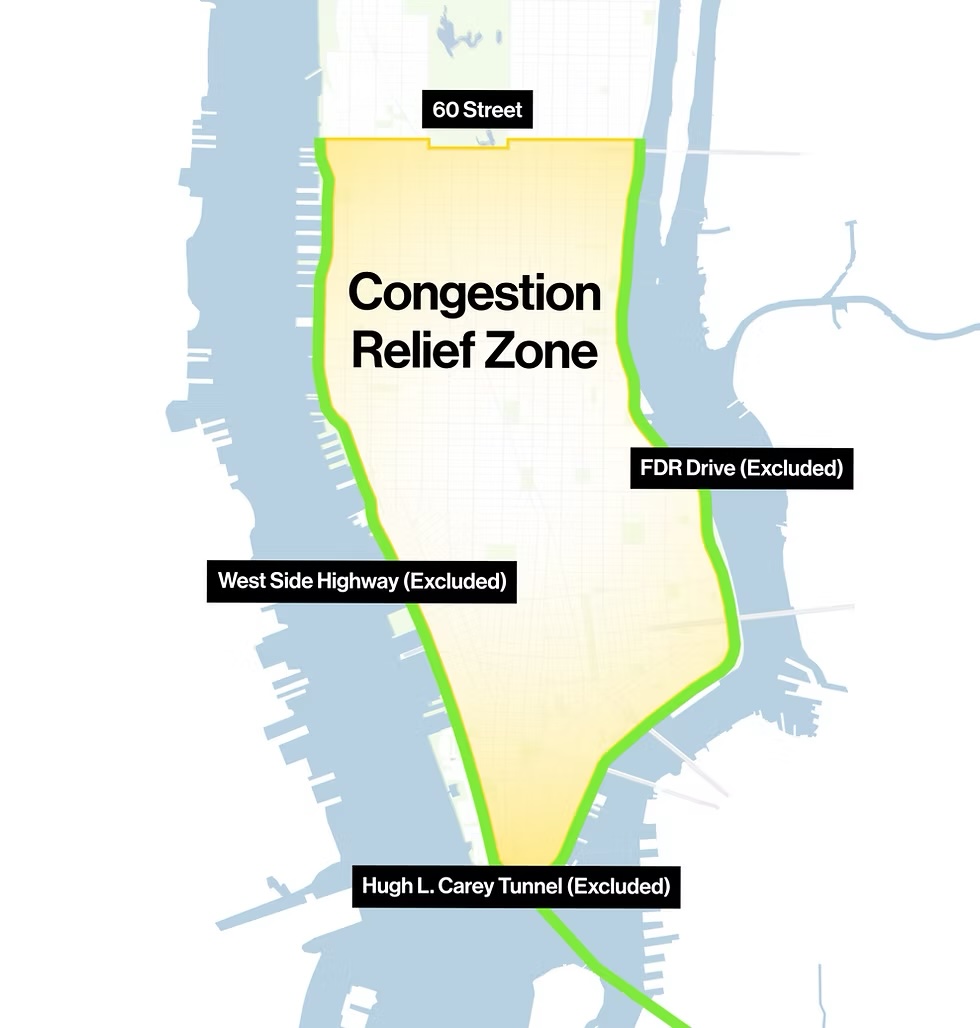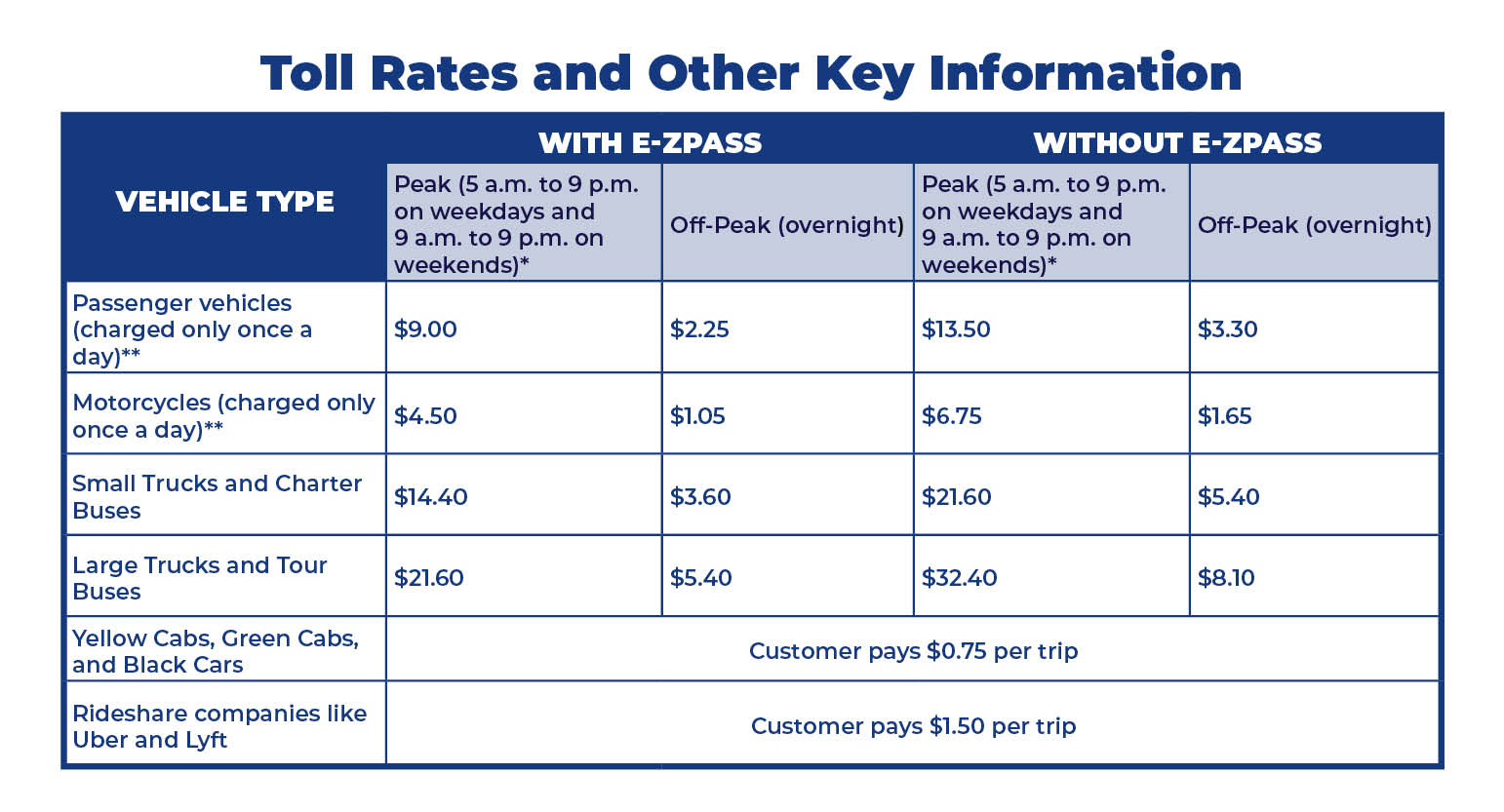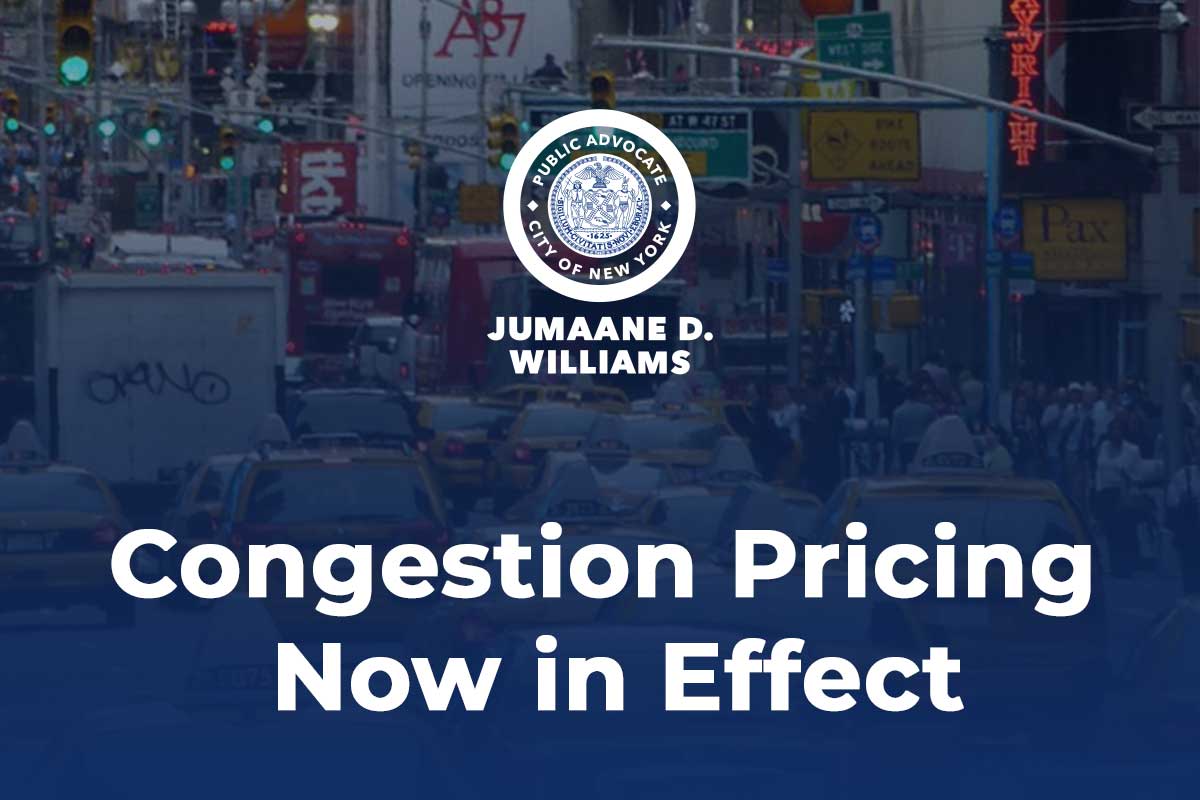On January 5, 2025, after a decades long fight by street safety, public transit, and environmental advocates, New York City put into place a new policy designed to raise funds for public transit improvements, decrease pollution, and incentivize greener modes of transportation. This policy, congestion pricing, was designed to raise money for the MTA's capital plan, while reducing traffic in Midtown by tolling drivers in Manhattan south of 60th Street. There are many exceptions and nuances to this toll, which this post will cover.

Here’s the breakdown of the toll structure:

Time of day
The peak period toll rate applies from 5 AM to 9 PM on weekdays, and from 9 AM to 9 PM on weekends. The overnight toll rates are 75% less than the respective rates in the standard peak period for all drivers entering the Congestion Relief Zone.
Type of vehicle
Passenger and small commercial vehicles, and motorcycles
- The toll for passenger and small commercial vehicles (sedans, SUVs, pick-up trucks, and small vans) paying with a valid E-ZPass is $9 during the peak period and $2.25 during the overnight period, when there is less congestion. The toll for motorcycles is $4.50 during the peak period and $1.05 during the overnight period. These vehicles are charged only once per day.
Trucks and buses
- Small trucks (single-unit trucks) and some buses pay a toll of $14.40 during the peak period and $3.60 during the overnight period. Large trucks (multi-unit trucks) and tour buses pay a toll of $21.60 during the peak period and $5.40 during the overnight period. Find more details about truck and bus types.
- Eligible trucks and buses are exempt from the Congestion Relief Zone toll. Read more about discounts and exemptions.
Taxis and for-hire vehicles
- Instead of paying the daily toll, taxis and for-hire vehicles licensed with the NYC Taxi & Limousine Commission are eligible for a smaller per-trip charge paid by the passenger for each trip to, from, within, or through the Congestion Relief Zone.
- For both the peak and overnight period, the per-trip charge for high-volume for-hire vehicles is $1.50. For taxis, green cabs, and black cars, the per-trip charge is $0.75.
- Read more about the Per-Trip Charge Plan
Crossing credits
- A credit reduces Congestion Relief Zone tolls for vehicles using a valid E-ZPass and entering during the peak period via one of the four tolled entries: Lincoln Tunnel, Holland Tunnel, Queens-Midtown Tunnel, and Hugh L. Carey Tunnel. The credit amount is up to $3 for passenger vehicles, up to $1.50 for motorcycles, up to $7.20 for small trucks and charter buses, and up to $12 for large trucks and tour buses. No crossing credits are offered overnight when the toll is reduced by 75% from the peak period toll.
Discounts and exemptions
- Discount and exemption plans are available for the Congestion Relief Zone. A discount plan is available for low-income drivers, and exemption plans are available for individuals with disabilities or organizations transporting people with disabilities, emergency vehicles, buses, and specialized government-owned vehicles.
- Low-Income Discount
- A 50% discount is available for low-income vehicle owners enrolled in the Low-Income Discount Plan (LIDP). This discount begins after the first 10 trips in a calendar month, and applies to all peak period trips after that. Learn more and apply for the Low-Income Discount Plan.
- Low-Income Tax Credit for Residents
- Residents of the Congestion Relief Zone whose New York State adjusted gross income is under $60,000 may qualify for a tax credit in the amount of tolls paid. Learn about the Central Business District toll tax credit for eligible residents.
- Disability Exemptions
- The Individual Disability Exemption Plan (IDEP) is available for individuals who have disabilities or health conditions that prevent them from using public transit. IDEP can be applied to a vehicle registered to the applicant, or to a vehicle registered to a person the applicant designates, such as a family member or a caregiver, if they use that vehicle to drive the applicant in the Congestion Relief Zone. Learn more about Individual Disability Exemption Plan and apply.
- The Organizational Disability Exemption Plan (ODEP) is available for organizations that operate vehicles that transport people with disabilities—such as Access-A-Ride, ambulette services, or schools and special education facilities. To qualify for the exemption, a vehicle must be used in the tolling zone solely for the purpose of transporting people with disabilities. Learn more about the Organizational Disability Exemption Plan and apply.
- Emergency Vehicle Exemption
- Qualifying authorized emergency vehicles as defined by New York State Vehicle and Traffic Law are exempt from the Congestion Relief Zone toll. Learn more about the Emergency Vehicle Exemption Plan and apply.
- Bus Exemption
- School buses contracted with the NYC Department of Education, commuter vans licensed with the NYC Taxi and Limousine Commission, and buses providing scheduled commuter services open to the public are exempt from the Congestion Relief Zone toll. Learn more about the Commuter Bus Exemption Plan and apply.
- Specialized Government-Owned Vehicle Exemption
- Publicly owned vehicles specifically designed to perform public works other than general transportation, and directly engaged in a core agency purpose, are exempt from the Congestion Relief Zone toll. Learn more about the Specialized Government-Owned Vehicle Exemption Plan and apply.
E-ZPass and Tolls by Mail
- Customers are able to use their E-ZPass tags to pay the Congestion Relief Zone toll as they do to pay tolls on other roads, bridges, and tunnels. Those without an E-ZPass tag will receive a Tolls by Mail bill to the registered owner of the vehicle. Tolls by Mail bills are more expensive and less convenient to pay. Learn more about signing up for E-ZPass.
- If you already have an E-ZPass, make sure your current license plate is linked to your E-ZPass account. This will ensure you’re charged the E-ZPass rate. If your E-ZPass was issued by New York State, you can check the status of your account on the E-ZPass NY website. If your E-ZPass was issued in another state, you'll need to check the appropriate state's E-ZPass website.
- In the first 60 days of the program, drivers are only being charged the applicable Congestion Relief Zone toll. No additional fees, charges, or fines, such as late fees, are being applied.
Tolls will be phased in by 2031
- The MTA is phasing in the toll structure over a six-year period with an initial $9 peak toll for cars. The toll will increase to $12 in 2028 and then $15 in 2031.
- See the full toll schedule, including toll rates to be phased in through 2031.
Why $9? How the Toll Rate Was Set
The base toll was originally set to be $15, a result of extensive studies on the cost of living expenses for those who drive and on a toll amount that would disincentivize people from driving. The $15 toll was one of several scenarios explored in the MTA’s Environmental Impact Statement in 2023, which was subsequently evaluated and approved by the Federal Highway Administration (FHWA) in a Finding of No Significant Impact. In June of 2024, Governor Kathy Hochul paused a congestion pricing plan that would have set this as the toll, stating that $15 was too costly for those who drive. In December 2024, Governor Hochul announced that congestion pricing would continue as planned, but the base toll would be reduced from $15 to $9, which is the least costly toll scenario that was evaluated by the MTA in 2023.
By law, if Governor Hochul had set the base toll lower than $9, this would have triggered a new federal environmental review that could take years to develop and get approved by the FHWA. With the newly elected Trump administration having sworn to block congestion pricing, any delays would have made it more complicated to implement this plan, decades in the making. The MTA is phasing in the toll structure over a six-year period with an initial $9 peak toll for cars. The toll is set to increase to $12 in 2028 and then $15 in 2031.
By Deputy Public Advocate for Infrastructure & Environmental Justice Kashif Hussain and Community Organizer for Infrastructure & Environmental Justice David Kahn
Images: Holger Stephan, Pixabay; MTA
Don't miss the latest from the Office of the Public Advocate. Subscribe to the Advocate Bulletin newsletter.
